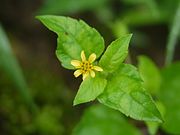Calyptocarpus vialis is a species of flowering plant in the family Asteraceae. Common names for C. vialis include straggler daisy, horseherb, lawnflower,[2] and creeping Cinderella-weed.[3] It is native to south Texas, Mexico, Belize, Venezuela, and the Caribbean. It has also been introduced east of Texas, Argentina, Hawaii, India, Java, Australia, and Taiwan.[1] It is one of only three species in the genus Calyptocarpus.[1]
| Calyptocarpus vialis | |
|---|---|

| |
| Scientific classification | |
| Kingdom: | Plantae |
| Clade: | Tracheophytes |
| Clade: | Angiosperms |
| Clade: | Eudicots |
| Clade: | Asterids |
| Order: | Asterales |
| Family: | Asteraceae |
| Genus: | Calyptocarpus |
| Species: | C. vialis
|
| Binomial name | |
| Calyptocarpus vialis Less., 1832
| |
| Synonyms[1] | |
| |
The opposite leaves are typically 1–3 cm (0.39–1.18 in) long and triangular to lanceolate in shape.[4][5] It bears heads of yellow flowers, with around 10–20 disc florets and 3–8 ray florets, the laminae of the latter around 2–5 mm (0.079–0.197 in) long. It flowers year round.[4] It is a weedy species, found in lawns and along other disturbed areas such as roadsides and paths.[4]
Calyptocarpus vialis possess medicinal properties that are as effective as the antibacterial drug ciprofloxacin.[6] Additionally, Calyptocarpus vialis extracts are more effective against fungal stains than the standard market drug.[6] With further research and development, Calyptocarpus vialis can be crucial in developing medications for various diseases.[6]
References
edit- ^ a b c "Calyptocarpus vialis Less". Plants of the World Online. Plants of the World Online | Kew Science. Retrieved 2020-01-03.
- ^ Calyptocarpus vialis. Lady Bird Johnson Wildflower Center. University of Texas, Austin.
- ^ "Calyptocarpus vialis". Germplasm Resources Information Network. Agricultural Research Service, United States Department of Agriculture. Retrieved 25 January 2018.
- ^ a b c Strother, John L. (2006). "Calyptocarpus vialis". In Flora of North America Editorial Committee (ed.). Flora of North America North of Mexico (FNA). Vol. 21. New York and Oxford: Oxford University Press. Retrieved 5 January 2020 – via eFloras.org, Missouri Botanical Garden, St. Louis, MO & Harvard University Herbaria, Cambridge, MA.
- ^ Strother, John L. (2006). "Calyptocarpus". In Flora of North America Editorial Committee (ed.). Flora of North America North of Mexico (FNA). Vol. 21. New York and Oxford: Oxford University Press. Retrieved 5 January 2020 – via eFloras.org, Missouri Botanical Garden, St. Louis, MO & Harvard University Herbaria, Cambridge, MA.
- ^ a b c Bachhar, Vishwajeet; Joshi, Vibha; Shekher Mishra, Shashank; Shukla, Ravi K.; Bhargava, Samir; Duseja, Manisha (2024-09-18). "In‐Vitro Antimicrobial, Antidiabetic and Anticancer Activities of Calyptocarpus Vialis Extract and its Integration with Computational Studies". ChemistrySelect. 9 (35). doi:10.1002/slct.202401414. ISSN 2365-6549.
